Practicing the CBSE Sample Papers for Class 10 Maths Basic Set 1 allows you to get rid of exam fear and be confident to appear for the exam.
CBSE Sample Papers for Class 10 Maths Basic Set 1 with Solutions
Time Allowed : 3 hours
Maximum Marks : 80
General Instructions:
- This Question Paper has 5 Sections A, B, C, D, and E.
- Section A has 20 Multiple Choice Questions (MCQs) carrying 1 mark each.
- Section B has 5 Short Answer-I (SA-I) type questions carrying 2 marks each.
- Section C has 6 Short Answer-Il (SA-II) type questions carrying 3 marks each.
- Section D has 4 Long Answer (LA) type questions carrying 5 marks each.
- Section E has 3 Case Based integrated units of assessment (4 marks each) with sub-parts of the values of 1,1 and 2 marks each respectively.
- All Questions are compulsory. However, an internal choice in 2 Qs of 2 marks, 2 Qs of 3 marks and 2 Questions of 5 marks has been provided. An internal choice has been provided in the 2 marks questions of Section E.
- Draw neat figures wherever required. Take n = \(\frac{22}{7}\) wherever required if not stated.
Section – A
(Section A consists of 20 Questions of 1 marks each.)
Question 1.
If two positive integers p and q can be expressed as p = ab2 and q = a3b; a, b being prime numbers, then LCM (p, q) is : [1]
(a) ab
(b) a2b2
(c) a3b2
(d) a3b3
Answer:
(c) a3b2
Explanation:
p = ab2 = a × b × b
and q = a3b = a × a × a × b
L.C.M. (p, q) = a × a × a × b × b
= a3b2
![]()
Question 2.
What is the greatest possible speed at which a man can walk 52 km and 91 km in an exact number of hours? [1]
(a) 17 km/hours
(b) 7 km/hours
(c) 13 km/hours
(d) 26 km/hours
Answer:
(c) 13 km/hours
Explanation:
Greatest possible speed = H.C.F. of given distances in an exact number of hours
∴ 52 = 13 × 4
and 91 = 13 × 7
∴ H.C.F. (52,91) =13 1
Hence, the greatest possible speed is 13 km/hours.
Question 3.
If one zero of the quadratic polynomial x2 + 3x + k is 2, then the value of k is: [1]
(a) 10
(b) – 10
(c) 5
(d) – 5
Answer:
(b) -10
Explanation:
Let p(x) = x2 + 3x + k
∴ p(2) = 22 + 3(2) + k
∵ 2 is a zero of the polynomial p(x).
∴ p(2) = 0
i.e., 4 + 6 + k = 0
⇒ k = – 10
![]()
Question 4.
Graphically, the pair of equations given by 6x – 3y + 10 = 0, 2x – y + 9 = 0 represents two lines which are: [1]
(a) intersecting at exactly one point
(b) parallel
(c) coincident
(d) intersecting at exactly two points.
Answer:
(b) Parallel
Explanation:
For equation,
6x – 3y + 10 = 0
Comparing with
a1e + b1y + c1 = 0,
we get a1 = 6,
b1 = – 3
and c1 = 10
and for equation,
2x – y + 9 = 0
Comparing with a2x + b2y + c2 = 0,
we get a2 = 2,
b2 = -1
and c2 = 9
Here, \(\frac{a_1}{a_2}=\frac{6}{2}=3\)
\(\frac{b_1}{b_2}=\frac{-3}{-1}=3\)
and \(\frac{c_1}{c_2}=\frac{10}{9}\)
∴ \(\frac{a_1}{a_2}=\frac{b_1}{b_2} \neq \frac{c_1}{c_2}\)
So, the system of linear equations is inconsistent (no solution) and graph will represent a pair of parallel lines.
Question 5.
If the quadratic equation x2 + 4x + k = 0 has real and equal roots, then (1)
(a) k < 4 (b) k > 4
(c) k = 4
(d) k > 4
Answer:
(c) k = 4
Explanation:
Given quadratic equation: x2 + 4x + k = 0
On comparing with ax2 + bx + c = 0, we get a = 1, b = 4 and c = k
For roots to be equal and real, b2 – 4ac = 0
⇒ (4)2 – 4 × 1 × k = 0
⇒ 16 – 4k = 0
⇒ 4k = 16
⇒ k = 4
Question 6.
The perimeter of a triangle with vertices (0, 4), (0, 0) and (3, 0) is : [1]
(a) 5 units
(b) 12 units
(c) 11 units
(d) (7 + √5) units 1
Answer:
(b) 12 units
![]()
Explanation:
From the figure
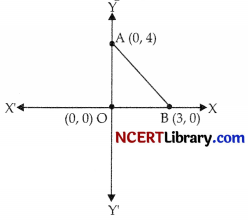
Perimeter of ∆AOB = OA + OB + AB
Here, OA = 4 units and OB = 3 units
AB = \(\sqrt{(3-0)^2+(0-4)^2}\)
(Using distance formula)
= \(\sqrt{(3)^2+(-4)^2}\)
= \(\sqrt{9+16}\)= \(\sqrt{25}\)
= 5 units
∴ Perimeter of the triangle = 4 + 3 + 5 = 12 units.
Question 7.
If in triangles ABC and DEF, \(\frac{A B}{D E}=\frac{B C}{F D}\) , then they will be similar, when [1]
(a) ∠B = ∠E
(b) ∠A = ∠D
(c) ∠B = ∠D
(d) ∠A = ∠F
Answer:
(c) ∠B = ∠D
Explanation:
In ∆ABC and ∆EDF
\(\frac{A B}{D E}=\frac{B C}{F D}\)
or, \(\frac{A B}{E D}=\frac{B C}{D F}\)
To, be similar of ∆ABC and ∆EDF, we must have ∠B = ∠D.
Question 8.
In which ratio the y-axis divides the line segment joining the points (5, – 6) and (-1, -4)? [1]
(a) 1:5
(b) 5:1
(c) 1:1
(d) 1:2
Answer:
(b) 5:1
Explanation:
Let the required point be P(0, a) and required ratio AP : PB = k : 1.
∴ 0 = \(\frac{k(-1)+1(5)}{k+1}\)
⇒ – k + 5 = 0
⇒ k = 5
Hence, required ratio is 5 : 1.
Question 9.
In the figure, if PA and PB are tangents to the circle with centre O such that ∠APB = 50°, then ∠OAB is equal to [1]
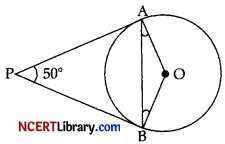
(a) 25°
(b) 30°
(c) 40°
(d) 50°
Answer:
(a) 25°
Explanation:
In PAB
PA = PB (Tangents are equal)
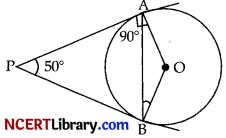
∴ ∠PAB = ∠PBA
(Isosceles angle property)
∠PAB + ∠PBA + ∠APB = 180°
(Angle sum property of a A)
⇒ 2 ∠PAB + 50° = 180°
⇒ 2 ∠PAB = 130°
⇒ ∠PAB = 65°
But ∠PAO = 90°
(OA is radius and PA is tangent)
Now, ∠OAB = ∠OAP – ∠PAB
= 90° – 65° = 25°
![]()
Question 10.
If sin A = \(\frac{1}{2}\), then the value of sec A is: [1]
(a) \(\frac{2}{\sqrt{3}}\)
(b) \(\frac{1}{\sqrt{3}}\)
(c) √3
(d) 1
Answer:
(a) \(\frac{2}{\sqrt{3}}\)
Explanation:
∵ sin A = \(\frac{1}{2}\)
⇒ sin A = sin 30°
⇒ A = 30°
So, sec A = sec 30°
= \(\frac{2}{\sqrt{3}}\)
Question 11.
√3 cos2 A + √3 sin2 A is equal to:
(a) 1
(b) \(\frac{1}{\sqrt{3}}\)
(c) √3
(d) 0
Answer:
(c) √3
Explanation:
√3 cos2 A + √3 sin2 A
= √3 (cos2 A + sin2 A)
= √3 × 1
[∵ cos2 A + sin2 A = 1]
= √3
Question 12.
The value of cos 1° cos 2° cos 3° cos 4° ……. cos 90° is: [1]
(a) 1
(b) 0
(c) -1
(d) 2
Answer:
(b) 0
Explanation:
∴ (cos 1°) × (cos 2°) × (cos 3°) × (cos 4°) ……. × (cos 90°)
= (cos 1°) × (cos 2°) × (cos 3°) × (cos 4°) ……. × (0)
[∵ cos 90° = 0]
= 0
![]()
Question 13.
If the perimeter of a circle is equal to that of a square, then the ratio of their areas is : [1]
(a) 22 : 7
(b) 14 : 11
(c) 7 : 22
(d) 11 : 14
Answer:
(b) 14 : 11
Explanation:
Let radius of circle be ‘r’ units and side of a square be ‘a’ units.
Given, Peramiter of a circle = Perimeter of a square
∴ 2πr = 4 a
a = \(\frac{πr}{2}\)
So,
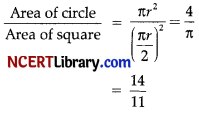
Question 14.
If the radii of two circles are in the ratio of 4:3, then their areas are in the ratio of ____. [1]
(a) 4 : 3
(b) 8 : 3
(c) 16 : 9
(d) 9 : 16
Answer:
(c) 16 : 9
Explanation:
Let r1 and r2 be the radii of two circles,
then, \(\frac{r_1}{r_2}=\frac{4}{3}\)
Now,

Hence, ratio of areas of two circles is 16 : 9.
Question 15.
The total surface area of a solid hemisphere of radius 7 cm is: [1]
(a) 447 π cm2
(b) 239 π cm2
(c) 174 π cm2
(d) 147 π cm2
Answer:
(d) 147 π cm2
Explanation: Total surface of hemisphere of radius r = 3πr2 [1]
= 3π × 7 × 7
= 147π cm2
![]()
Question 16.
For the following distribution :
Table 1
the upper limit of the modal class is: [1]
(a) 10
(b) 15
(c) 20
(d) 25
Answer:
(c) 20
Explanation:
Class interval of given highest frequency is 15 – 20.
Hence, the upper limit of the modal class is 20.
Question 17.
If the mean of the following distribution is 2.6, then the value of y is : [1]
Table 2
(a) 3
(b) 8
(c) 13
(d) 24
Answer:
(b) 8
Explanation:
Table 3
Mean = 2.6 (given)
\(\frac{\Sigma fx}{\Sigma f}\) = 2.6
⇒ \(\frac{28+3 y}{12+y}\) = 2.6
⇒ 28 + 3 y = 31.2 + 2.6 y
⇒ 0.4y = 3.2
⇒ y = 8
Question 18.
A card is selected at random from a well shuffled deck of 52 cards. The probability of its being a red face card is: [1]
(a) \(\frac{3}{26}\)
(b) \(\frac{3}{13}\)
(c) \(\frac{2}{13}\)
(d) \(\frac{1}{2}\)
Answer:
(a) \(\frac{3}{26}\)
Explanation:
Total outcomes,
n(s) = 52
Number of red face cards = 6
i.e., Favourable outcomes, n(A) = 6
P(a red face card) = \(\frac{n(A)}{n(s)}\)
= \(\frac{6}{52}\) = \(\frac{3}{26}\)
Direction for question 19 & 20: In question number 19 and 20, a statement of Assertion
(A) is followed by a statement of Reason (R). Choose the correct option as:
(a) Both assertion (A) and reason (R) are true and reason (R) is the correct explanation of assertion (A).
(b) Both assertion (A) and reason (R) are true but reason (IQ is not the correct explanation of assertion (A).
(c) Assertion (A) is true but reason (R) is false.
(d) Assertion (A) is false but reason (R) is true.
Question 19.
Assertion (A): If HCF of 510 and 92 is 2, then the LCM of 510 & 92 is 32460
Reason (R): as HCF(a, b) × LCM(a, b) = a × b. [1]
Answer:
(d) Assertion (A) is false but reason (R) is true
Explanation:
For assetion,
Primer factor of 510 = 2 × 3 × 5 × 17
and, Primer factor of 92 = 2 × 2 × 23
∴ HCF (510, 92) = 2
LCM (510, 92) = 2 × 2 × 3 × 5 × 17 × 23
= 23460
But L.C.M. (510,92) is given 32460, which is wrong.
Hence, assertion is false.
For reason,
Since, product of two numbers is equal to the product of H.C.F. and L.C.M. of given two numbers.
Hence, reason is true.
![]()
Question 20.
Assertion (A): The ratio in which the line segment joining (2, -3) and (5, 6) internally divided by x axis is 1: 2.
Reason (R): as formula for the internal division is
\(\left(\frac{m x_2+n x_1}{m+n}, \frac{m y_2+n y_1}{m+n}\right)\) [1]
Answer:
(a) Both assertion (A) and reason (R) are true and reason (R) is the correct explanation of assertion (A).
Explanation:
For assertion,
Let the required point be P(a, 0) and required ratio AP : PB = k : 1.
Using section formula,
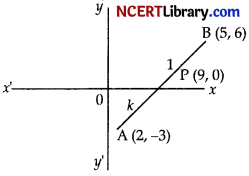
x = \(\frac{m x_2+n x_1}{m+n}\) , y = \(\frac{m y_2+n y_1}{m+n}\)
0 = \(\frac{k \times 6+1 \times(-3)}{k+1}\)
⇒ 6k – 3 = 0
⇒ 6k = 3
⇒ k = \(\frac{3}{6}\) = \(\frac{1}{2}\)
Hence, assertion is true.
For reason,
As we know that the section formula:
p(x, y) = \(\left(\frac{m x_2+n x_1}{m+n}, \frac{m y_2+n y_1}{m+n}\right)\)
Hence, reason is the explanation of assertion.
Section – B (10 marks)
(Section B consists of 5 questions of 2 marks each.)
Question 21.
For what values of k will the following pair of linear equations have infinitely many solutions? [2]
kx + 3y – (k – 3) = 0
12x + ky – k = 0
Answer:
For a pair of linear equations to have infinitely many solutions:
\(\frac{a_1}{a_2}=\frac{b_1}{b_2}=\frac{c_1}{c_2}\)
⇒ \(\frac{k}{12}=\frac{3}{k}=\frac{k-3}{k}\)
Now, \(\frac{k}{12}=\frac{3}{k}\)
⇒ k2 = 36
⇒ k = ± 6
Also, \(\frac{3}{k}=\frac{k-3}{k}\)
⇒ k2 – 6k = 0
⇒ k = 0, 6.
Therefore, the value of k, that satisfies both the conditions, is k = 6.
Question 22.
In the figure, altitudes AD and CE of ∆ ABC intersect each other at the point P. Show that: [2]
(i) ∆ADB ~ ∆CEB
(ii) ∆PDC ~ ∆BEC
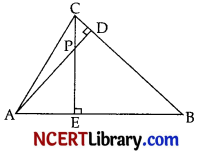
OR
In the figure, DE || AC and DF || AE. Prove that \(\frac{B F}{F E}=\frac{B E}{E C}\)
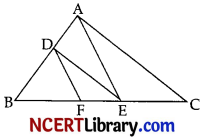
Answer:
(i) In ∆ABD and ∆CBE
∠ADB = ∠CEB = 90°
∠ABD = ∠CBE (Common angle)
⇒ ∆ABD ~ ∆CBE (AA criterion)

(ii) In ∆PDC and ∆BEC
∠PDC = ∠BEC = 90°
∠PCD = ∠BCE (Common angle)
⇒ ∆PDC ~ ∆BEC (AA criterion)
OR
In ∆ABC, DE || AC
\(\frac{\mathrm{BD}}{\mathrm{AD}}=\frac{\mathrm{BE}}{\mathrm{EC}}\) ….. (ii) (Using BPT)

In ∆ABE, DF || AE
\(\frac{\mathrm{BD}}{\mathrm{AD}}=\frac{\mathrm{BF}}{\mathrm{FE}}\) ….. (ii) (Using BPT)
From (i) and (ii)
\(\frac{B D}{A D}=\frac{B E}{E C}=\frac{B F}{F E}\)
Thus, \(\frac{B F}{F E}=\frac{B E}{E C}\)
![]()
Question 23.
Two concentric circles are of radii 5 cm and 3 cm. Find the length of the chord of the larger circle which touches the smaller circle. [2]
Answer:
Let O be the centre of the concentric circle of radii 5 cm and 3 cm respectively. Let AB be a chord of the larger circle touching the smaller circle at P.
Then AP = PB and OP ⊥ AB
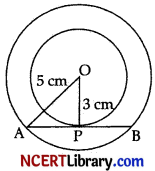 Applying Pythagoras theorem in ∆OPA, we have
Applying Pythagoras theorem in ∆OPA, we have
OA2 = OP2 + AP2
⇒ 25 = 9 + AP2
⇒ Ap2 = 16
⇒ AP = 4 cm
∴ AB = 2AP = 8 cm
Question 24.
If cot θ = \(\frac{7}{8}\), evaluate: \(\frac{(1+\sin \theta)(1-\sin \theta)}{(1+\cos \theta)(1-\cos \theta)}\) [2]
Answer:
Now,
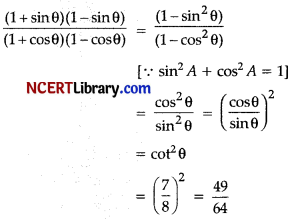
![]()
Question 25.
Find the perimeter of a quadrant of a circle of radius 14 cm. [2]
OR
Find the diameter of a circle whose area is equal to the sum of the areas of the two circles of radii 24 cm and 7 cm.
Answer:
Perimeter of quadrant = 2r + \(\frac{1}{4}\) × 2 πr
⇒ Perimeter = 2 × 14+ \(\frac{1}{2}\) × \(\frac{22}{7}\) × 14
⇒ Perimeter = 28 + 22 = 50 cm
OR
Area of the circle = Area of first circle + Area of second circle
⇒ πR2 = π (r1)2 + π (r2)2
⇒ πR2 = π (24)2 + π (7)2
⇒ πR2 = 576π + 49π
⇒ πR2 = 625π
⇒ R2 = 625
⇒ R = 25
Thus, diameter of the circle = 2R = 50 cm.
Section – C (18 marks)
(Section – C consists of 6 questions of 3 marks each.)
Question 26.
Prove that \(\sqrt{5}\) is an irrational number. [3]
Answer:
Let us assume to the contrary, that √5 is rational
Then we can find a and b (≠ 0) such that \(\sqrt{5}\) = \(\frac{a}{b}\) (assuming that a and b are co-primes).
So, a = \(\sqrt{5}\) b ⇒ a2 = 5b2
Here 5 is a prime number that divides a2 then 5 divides a.
(Using the theorem, if a is a prime number and if a divides p2, then a divides p, where a is a positive integer)
Thus 5 is a factor of a.
Since 5 is a factor of a, we can write a = 5c (where c is a constant).
Substituting a = 5c
We get (5c)2 = 5b2 ⇒ 5c2 = b2
This means 5 divides b2 so 5 divides b also.
(Using the theorem, if a is a prime number and if a divides p2, then a divides p, where a is a positive integer).
Hence a and b have at least 5 as a common factor.
But this contradicts the fact that a and b are coprime.
This is the contradiction to our assumption that p and q are co-primes.
So, \(\sqrt{5}\) is not a rational number. Therefore, the \(\sqrt{5}\) is irrational.
Question 27.
Find the zeroes of the quadratic polynomial 6x2 – 3 – 7x and verify the relationship between the zeroes and the coeffcients. [3]
Answer:
6x2 – 7x – 3 = 0
⇒ 6x2 – 9x + 2x – 3 =0
⇒ 3x(2x – 3) + 1(2x – 3) = 0
⇒ (2x – 3)(3x + 1) = 0
⇒ 2x – 3 = 0 and 3x + 1 = 0
x = \(\frac{3}{2}\) and x = \(\frac{-1}{3}\)
Hence, the zeros of the quadratic polynomials are \(\frac{3}{2}\) and \(\frac{-1}{3}\)
For verification
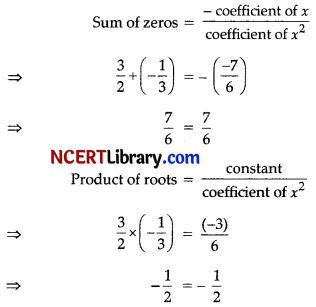
Therefore, the relationship between zeroes and their coefficients is verified.
Question 28.
A shopkeeper gives books on rent for reading. She takes a fixed charge for the first two days, and an additional charge for each day there after. Latika paid ₹ 22 for a book kept for six days, while Anand paid ? 16 for the book kept for four days. Find the fixed charges and the charge for each extra day. [3]
OR
Places A and B are 100 km apart on a highway. One car starts from A and another from B at the same time. If the cars travel in the same direction at different speeds, they meet in 5 hours. If they travel towards each other, they meet in 1 hour. What are the speeds of the two cars?
Answer:
Let the fixed charge by ₹ x and additional charge by ₹ y per day.
Number of days for Latika = 6 = 2 + 4
Hence, Charge x + 4y = 22
x = 22 – 4y ……….(i)
Number od days for Anand = 4 = 2 + 2
Hence, Charge x + 2y = 16
x = 16 – 2 y ………. (ii)
On comparing equation (i) and (ii), we get,
22 – 4y = 16 – 2y
⇒ 2y = 6
⇒ y = 3
Substituting y = 3 in equation (i), we get
x = 22 – 4 (3)
⇒ x = 22 – 12
⇒ x = 10
Therefore, fixed charge = ₹ 10 and additional charge = ₹ 3 per day
OR
![]()
AB = 100 km. We know that,
Distance = Speed × Time.
AP – BP = 100
⇒ 5x – 5y = 100
⇒ x – y = 20 ………. (i)
AQ + BQ = 100
⇒ x + y = 100 ………. (ii)
Adding equations (i) and (ii), we get,
x – y + x + y = 20 + 100
⇒ 2x = 120
⇒ x = 60
Substituting x = 60 in equation (ii), we get
60 + y = 100
⇒ y = 40
Therefore, the speed of the first car is 60 km/hr and
the speed of the second car is 40 km/hr.
Question 29.
In the figure, PQ is a chord of length 8 cm of a circle of radius 5 cm. The tangents at P and Q intersect at a point T. Find the length TP. [3]
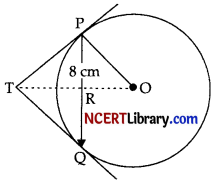
Answer:
Since OT is perpendicular bisector of PQ.
Therefore, PR = RQ = 4 cm
Now,OR = \(\sqrt{O P^2-P R^2}\)
= \(\sqrt{5^2-4^2}\) = 3 cm
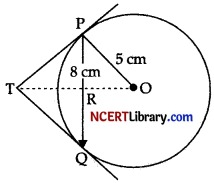
Now, ∠TRP + ∠RPO = 90° (∵ ∠TPO = 90°)
and ∠TPR + ∠PTR = 90° (∵ ∠TRP = 90°)
So, ∠RPO = ∠PTR
So, ∆TRP ~ ∆PRO
[By A-A Rule of similar triangles]
So, \(\frac{T P}{P O}=\frac{R P}{R O}\)
⇒ \(\frac{TP}{5}=\frac{4}{3}\)
⇒ TP = \(\frac{20}{3}\) cm
Question 30.
Prove that
\(\frac{\tan \theta}{1-\cot \theta}+\frac{\cot \theta}{1-\tan \theta}\) = 1 + sec θ cosec θ. [3]
OR
If sin θ + cos θ = \(\sqrt{3}\), then prove that tan θ + cot θ = 1.
Answer:
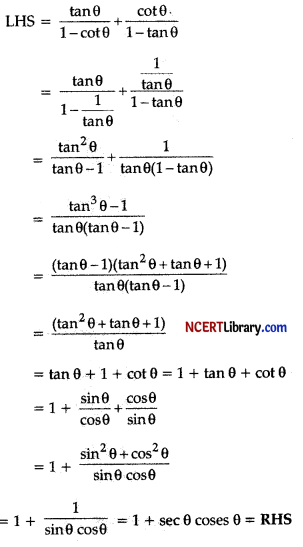
OR
sin θ + cos θ = \(\sqrt{3}\)
⇒ (sin θ + cos θ)2 = 3
⇒ sin2θ + cos2θ + 2 sin θ cos θ = 3
⇒ 1 + 2 sin θ cos θ = 3
⇒ sin θ cos θ = 1 ………(i)
Now, tan θ + cot θ = \(\frac{\sin \theta}{\cos \theta}+\frac{\cos \theta}{\sin \theta}\)
= \(\frac{\sin ^2 \theta+\cos ^2 \theta}{\sin \theta \cos \theta}\)
= \(\frac{1}{\sin \theta \cos \theta}\) = \(\frac{1}{1}\) = 1
Hence Proved.
Question 31.
Two dice are thrown at the same time. What is the probability that the sum of the two numbers appearing on the top of the dice is : [3]
(i) 8?
(ii) 13?
(iii) less than or equal to 12?
Answer:
(i) P(8) = \(\frac{5}{36}\)
(ii) P(13) = \(\frac{0}{36}\) = 0
(iii) P (less than or equal to 12) = 1
Detailed Answer:
Given:
Sample space for two dice S = {(1,1), (1,2), (1,3), (1,4), (1,5), (1,6)
(2,1), (2,2), (2,3), (2,4), (2,5), (2,6),
(3, 1), (3, 2), (3,3), (3,4), (3,5), (3,6),
(4, 1), (4,2), (4,3), (4,4), (4,5), (4,6),
(5, 1), (5,2), (5,3), (5,4), (5,5), (5,6),
(6,1), (6,2), (6,3), (6,4), (6,5), (6,6)}
∴ n(s) = 36
(i) Let E be the sum of two numbers appearing on the top of the dice is 8
or, E = {(2,6), (3, 5), (4,4), (5,3), (6,2)}
∴ n(E) = 5
Required probability = \(\frac{1}{2}\) = \(\frac{1}{2}\)
(ii) Let E be the sum of two numbers appearing on the top of the dice is 13
or, E = ϕ
∴ n(E) = 0
Required probability = \(\frac{0}{36}\) = 0 .
(iii) Let E be the sum of two numbers appearing on the top of the dice is less than or equal to 12.
So, n(E) = 36
Required probability = \(\frac{36}{36}\) = 1
Section – D (20 marks)
(Section – D consists of 4 questions of 5 marks each.)
Question 32.
An express train takes 1 hour less than a passenger train to travel 132 km between Mysore and Bangalore (without taking into consideration the time they stop at intermediate stations). If the average speed of the express train is 11km/h more than that of the passenger train, find the average speed of the two trains. [5]
OR
A motor boat whose speed is 18 km/h in still water takes 1 hour more to go 24 km upstream than to return downstream to the same spot. Find the speed of the stream.
Answer:
Let the average speed of passenger train = x km/h.
and the average speed of express train = (x + 11) km/h
As per given data, time taken by the express train to cover 132 km is 1 hour less than the passenger train to cover the same distance. Therefore,
\(\frac{132}{x}-\frac{132}{x+11}\) = 1
⇒ \(\frac{132(x+11-x)}{x(x+11)}\) = 1
⇒ \(\frac{132 \times 11}{x(x+11)}\) = 1
⇒ 132 × 11 = x(x + 11)
⇒ x2 + 11x – 1452 = 0
⇒ x2 + 44x – 33x – 1452 = 0
⇒ x (x + 44) – 33(x + 44) = 0
⇒ (x + 44)(x – 33) = 0
⇒ x = – 44, 33
As the speed cannot be negative, the speed of the passenger train will be 33 km/h and the speed of the express train will be 33 + 11 = 44 km/h.
OR
Let the speed of the stream be x km/hr
So, the speed of the boat in upstream = (18 – x) km/hr
and the speed of the boat in downstream = (18 + x) km/hr
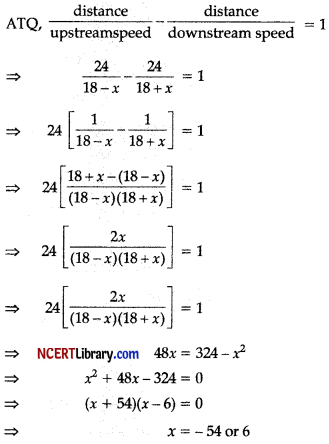
As speed to stream con never be negative, the speed of the stream is 6 km/hr.
Question 33.
Prove that If a line is drawn parallel to one side of a triangle to intersect the other two sides in distinct points, the other two sides are divided in the same ratio. In the figure, find EC if \(\frac{A D}{D B}=\frac{A E}{E C}\) using the above theorem. [5]
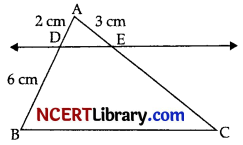
Answer:
Figure,
Given, To Prove, contructions
Proof
Application
Given: ∆ABC, wherePQ || BC.
To Prove: \(\frac{A P}{B P}=\frac{A Q}{C Q}\)
Contructions:
Join BQ and PC
Draw PR AQ or AC
and QS AP oor AB
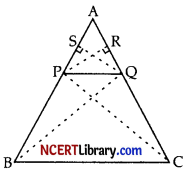
Proof:
Proof: ∆PQB and ∆PQC are on the same base PQ and lie between sanie parallel PQ and BC.
So, ar(∆PQB) = ar(∆PQC) ………(i)
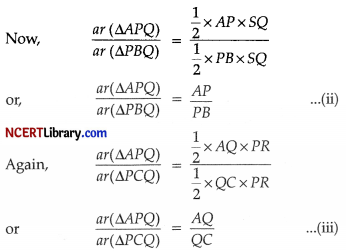
From (i), (ii) and (iii), we get
\(\frac{A P}{B P}=\frac{A Q}{Q C}\)
Hence Proved.
Given:
AD = 2 cm
AE = 3 cm

and BD = 6 cm
and \(\frac{A D}{D B}=\frac{A E}{E C}\)
or, \(\frac{2}{6}=\frac{3}{E C}\)
or, EC = 9 cm
Question 34.
A pen stand made of wood is in the shape of a cuboid with four conical depressions to hold pens. The dimensions of the cuboid are 15 cm by 10 cm by 3.5 cm. The radius of each of the depressions is 0.5 cm and the depth is 1.4 cm. Find the volume of wood in the entire stand. [5]

OR
Ramesh made a bird-bath for his garden in the shape of a cylinder with a hemispherical depression at one end. The height of the cylinder is 1.45 m and its radius is 30 cm. Find the total surface area of the bird-bath.
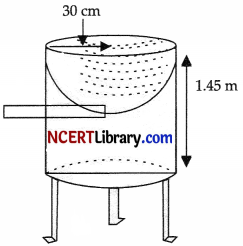
Answer:
Volume of one conical depression
= \(\frac{1}{3}\) × πr2h
= \(\frac{1}{3}\) × \(\frac{22}{7}\) × 0.52 × 1.4 cm3
= 0.366 cm3
Volume of 4 conical depression = 4 × 0.366 cm3
= 1.464 cm3

Volume of cuboidal box = L × B × H
= 15 × 10 × 3.5 cm3 = 525 cm3
Remaining volume of box = Volume of cuboidal box – Volume of 4 conical depressions
= 525 cm3 – 1.464 cm3
= 523.5 cm3
OR
Let h be height of the cylinder, and r the common radius of the cylinder arid hemisphere.
Then, the total surface area = CSA of cylinder + CSA of hemisphere
= 2 πrh + 2πr2 = 2πr(h + r)

= 2 × \(\frac{22}{7}\) × 30(145 + 30) cm2
= 2 × \(\frac{22}{7}\) × 30 × 175 cm2
= 33000 cm2 = 3.3 m2
Question 35.
A life insurance agent found the following data for distribution of ages of 100 policy holders. Calculate the median age, if policies are given only to persons having age 18 years onwards but less than 60 years. [5]
| Age (in years) | Number of policy holders |
| Below 20 | 2 |
| 20-25 | 4 |
| 25-30 | 18 |
| 30-35 | 21 |
| 35-40 | 33 |
| 40-45 | 11 |
| 45-50 | 3 |
| 50-55 | 6 |
| 55-60 | 2 |
Answer:
| Class Interval | Number of policy holders (f) | Cumulative Frequency (cf) |
| Below 20 | 2 | 2 |
| 20-25 | 4 | 6 |
| 25-30 | 18 | 24 |
| 30-35 | 21 | 45 |
| 35-40 | 33 | 78 |
| 40-45 | 11 | 89 |
| 45-50 | 3 | 92 |
| 50-55 | 6 | 98 |
| 55-60 | 2 | 100 |
n = 100 ⇒ \(\frac{n}{2}\) = 50,
Therefore, median class = 35 – 40,
Class size, h = 5, Lower limit of median class, l = 35,
frequency f = 33, cumulative frequency cf = 45
⇒ Median = l + \(\left[\frac{\frac{n}{2}-c f}{f}\right]\) × h
⇒ Median = 35 + \(\left[\frac{50-45}{33}\right]\) × 5
= 35 + \(\frac{25}{33}\) = 35 + 0.76
= 35.76
Therefore, median age is 35.76 years
SECTION – E (12 marks)
(Case Study Based Questions are compulsory.)
(Section E consists of 3 questions. All are compulsory.)
Case Study -1
Question 36.
In the month of April to June 2022, the exports of passenger cars from India increased by 26% in the corresponding quarter of 2021-22, as per a report. A car manufacturing company planned to produce 1800 cars in 4th year and 2600 cars in 8th year. Assuming that the production increases uniformly by a fixed number every year.
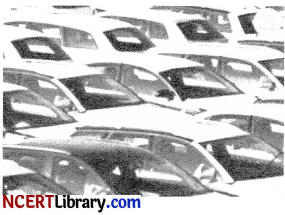
Based on the above information answer the following questions.
I. Find the production in the 1st year. [1]
II. Find the production in the 12th year. [1]
III. Find the total production in first 10 years. [2]
OR
In which year the total production will reach to 15000 cars? [2]
Answer:
I. Since the production increases uniformly by a fixed number every year, the number of Cars manufactured in 1st, 2nd, 3rd, ….years will form an AP.
So, a + 3d = 1800 and a + 7d = 2600
On solving, we get
d = 200 and a = 1200
II. t12 = a + 11d
⇒ t12 = 1200 + 11 × 200
⇒ t12 = 3400
Hence, company manufactures 3,400 cars in 12th year.
III. Sn = \(\frac{n}{2}\)[2a + (n – 1)d]
⇒ S10 = \(\frac{10}{2}\) [2 × 1200+ (10 – 1)200]
⇒ S10 = \(\frac{13}{2}\) [2 × 1200 + 9 × 200]
⇒ S10 = 5 × [2400 + 1800]
⇒ S10 = 5 × 4200 = 21000
OR
Let in n years the production will reach to 31200.
Sn = \(\frac{n}{2}\) [2a + (n – 1)d]
⇒ 31200 = \(\frac{n}{2}\) [2a + (n – 1)d]
⇒ \(\frac{n}{2}\) [2 × 1200 + (n – 1)200] = 31200
⇒ n2 + 11n – 312 = 0
⇒ n2 + 24n – 13n – 312 = 0
⇒ (n + 24) (n – 13) = 0
⇒ n = 13 or – 24. As n can’t be negative. So, n = 13
Case Study – 2
Question 37.
In a GPS, The lines that run east-west are known as lines of latitude, and the lines running north-south are known as lines of longitude. The latitude and the longitude of a place are its coordinates and the distance formula is used to find the distance between two places. The distance between two parallel lines is approximately 150 km. A family from Uttar Pradesh planned a round trip from Lucknow (L) to Puri (P) via Bhuj (B) and Nashik (N) as shown in the given figure below.
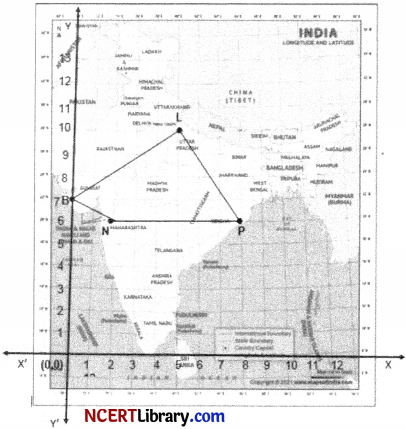
Based on the above information answer the following questions using the coordinate geometry.
I. Find the distance between Lucknow (L) to Bhuj (B). [1]
II. If Kota (K), internally divide the line segment joining Lucknow (L) to Bhuj (B) into 3 : 2 then find the coordinate of Kota (K). [1]
III. Name the type of triangle formed by the places Lucknow (L), Nashik (N) and Puri (P)
OR
Find a place (point) on the longitude (y-axis) which is equidistant from the points Lucknow (L) and Puri (P). [2]
Answer:
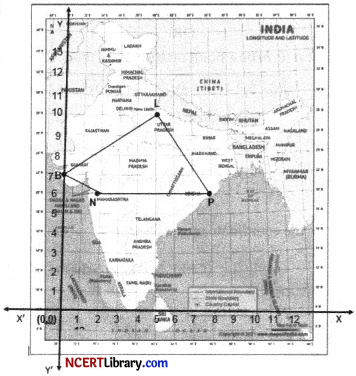
I. LB = \(\sqrt{\left(x_2-x_1\right)^2+\left(y_2-y_1\right)^2}\)
⇒ LB = \(\sqrt{(0-5)^2+(7-10)^2}\)
LB = \(\sqrt{(5)^2+(3)^2}\)
⇒ LB = \(\sqrt{25 + 9}\)
LB = \(\sqrt{34}\)
Hence the distance is 150\(\sqrt{34}\) km.
II. Coordinate of kota(K) is
= \(\left(\frac{3 \times 5+2 \times 0}{3+2}, \frac{3 \times 7+2 \times 10}{3+2}\right)\)
= \(\left(\frac{15+0}{5}, \frac{21+20}{5}\right)=\left(3, \frac{41}{5}\right)\)
III. L(5, 10), N(2, 6), P(8, 6)
LN = \(\sqrt{(2-5)^2+(6-10)^2}\)
= \(\sqrt{(3)^2+(4)^2}\)
= \(\sqrt{9 + 16}\)
= \(\sqrt{25}\) = 5
NP = \(\sqrt{(8-2)^2+(6-6)^2}\)
= \(\sqrt{(4)^2+(0)^2}\) = 4
PL = \(\sqrt{(8-5)^2+(6-10)^2}\)
= \(\sqrt{(3)^2+(4)^2}\)
= \(\sqrt{9 + 16}\)
= \(\sqrt{25}\) = 5
as LN = PL ≠ NP, so D LNP is an isosceles triangle
OR
Let A (0, b) be a point on the y – axis then AL = AP.
⇒ \(\sqrt{(5-0)^2+(10-b)^2}\) = \(\sqrt{(8-0)^2+(6-b)^2}\)
⇒ (5)2 + (10 – b)2 = (8)2 + (6 – b)2
⇒ 25 + 100 – 20b + b2 = 64 + 36 – 12b + b2
⇒ 8b = 25 ⇒ b = \(\frac{25}{8}\)
So, the coordinate on y axis is (0, \(\frac{25}{8}\))
Case Study – 3
Question 38.
Lakshaman Jhula is located 5 kilometers north-east of the city of Rishikesh in the Indian state of Uttarakhand. The bridge connects the villages of Tapovan to Jonk. Tapovan is in Tehri Carhwal district, on the west bank of the river, while Jonk is in Pauri Garhwal district, on the east bank. Lakshman Jhula is a pedestrian bridge also used by motorbikes. It is a landmark of Rishikesh. A group of Class X students visited Rishikesh in Uttarakhand on a trip. They observed from a point (P) on a river bridge that the angles of depression of opposite banks of the river are 60° and 30° respectively. The height of the bridge is about 18 meters from the river. [2]
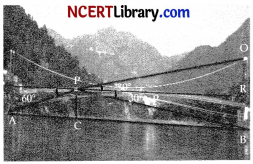
Based on the above information answer the following questions.
(A) Find the distance PA. [1]
(B) Find the distance PB. [1]
(C) Find the width AB of the river.
OR
Find the height BQ if the angle of the elevation from P to Q be 30°. [2]
Answer:
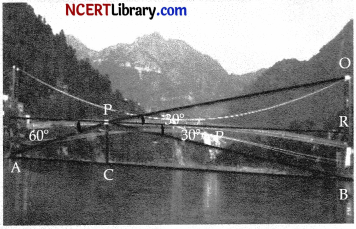
I. sin 60° = \(\frac{P C}{P A}\)
⇒ \(\frac{\sqrt{3}}{2}=\frac{18}{\mathrm{PA}}\)
⇒ PA = \(12 \sqrt{3}\) m
II. sin 30° = \(\frac{\mathrm{PC}}{\mathrm{PB}}\)
⇒ \(\frac{1}{2}=\frac{18}{P B}\)
⇒ PB = 36 m
III. tan 60° = \(\frac{P C}{A C}\)
⇒ \(\sqrt{3}\) = \(\frac{18}{\mathrm{AC}}\)
⇒ AC = \(6 \sqrt{3}\) m
tan 30° = \(\frac{P C}{C B}\)
⇒ \(\frac{1}{\sqrt{3}}=\frac{18}{C B}\)
⇒ CB = \(18 \sqrt{3}\) m
Width AB = AC + CB
= \(6 \sqrt{3}\) + \(18 \sqrt{3}\)
= \(24 \sqrt{3}\) m
OR
RB = PC = 18 m and PR = CB = \(18 \sqrt{3}\) m
tan 30° = \(\frac{\mathrm{QR}}{\mathrm{PR}}\)
⇒ \(\frac{1}{\sqrt{3}}=\frac{Q R}{18 \sqrt{3}}\)
⇒ QR = 18m
QB = QR + RB
= 18 + 18 = 36 m.
Hence, height BQ is 36 m.